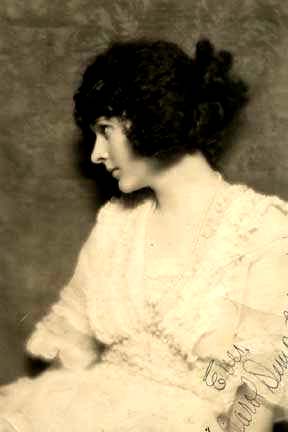 Carol Dempster
Carol Dempster was born in Duluth, MN. on Dec. 8, 1901.
The family moved to California for unknown reasons. Dempster was
dancing at a school entertainment when Ruth St. Denis recruited
her for her dancing school. She was spotted by D.W. Griffith and
got her first screen role as one of the dancers in the Babylonian
sequence of "Intolerance" (1916). Her next role was
as the girl who wants to go dancing with Robert Harron in "A
Romance of Happy Valley" (1919) followed by a role in Dorothy
Gish's "The Hope Chest" (1919). She had another minor
role in 'True Heart Susie" (1919) and then got her first
featured part in "The Girl Who Stayed at Home" (1919)
with Robert Harron and Clarine Seymour. The part was originally
intended to go to Lillian Gish, but reportedly she was "over-tired,"
and Dempster got the part. Critics offered mild praise. She next
co-starred with Richard Barthelmess in "Scarlet Days"
(1920), one of Griffith's worst efforts. Her first solo starring
role was in "The Love Flower" (1920) in which she is
on a South Sea island with her father who is hiding from his pursuer.
The critics were not kind toward in the comments about her performance.
Following one more passable performance in a Griffith picture,
"Dream Street" (1921), she co-starred in her first non-Griffith
feature, "Sherlock Holmes" (1922) with John Barrymore,
for which she received mild praise. Griffith starred her once
more in "One Exciting Night" (1922), a film many consider
Griffith's poorest work. The film was not successful. Next was
"The White Rose" (1923) which was a starring vehicle
for Mae Marsh. Griffith attempted another "Birth of a Nation"
type epic with "America" in 1923 teaming Dempster and
Neil Hamilton, but it, too, was not a success. "Isn't Life
Wonderful" (1924), again with Dempster and Hamilton, is possibly
her best effort. It was shot in Germany and depicted two lovers
trying to survive in the post-war depression. Although it was
a critical success, it was not a financial success, and Griffith
was finally forced to give up his independence and sign with Paramount.
He starred Dempster in two films for the studio, "Sally of
the Sawdust" (1925) and "That Royle Girl" (1925),
both co-starring W.C. Fields, but both films are considered mediocre
at best. Possibly her best performance was in her last film --
"The Sorrows of Satan" (1927) co-starring Ricardo Cortez
and Adolphe Menjou. Although critics weren't favorable toward
the film, the public was, and it was a money-maker for Griffith.
Dempster married New York banker Edwin S. Larsen in 1929. She
lived happily with her husband in La Jolla, CA., until her death
Feb. 1, 1991.
Selected films of this director available for viewing:
The Girl Who Stayed At Home (1919)
True Heart Susie (1919)
Dream Street (1921)
One Exciting Night (1922)
America (1924)
Isn't Life Wonderful (1924)
Sally of the Sawdust (1925)
That Royle Girl (1925)
Sorrows of Satan (1926)
Carol Dempster
Carol Dempster was born in Duluth, MN. on Dec. 8, 1901.
The family moved to California for unknown reasons. Dempster was
dancing at a school entertainment when Ruth St. Denis recruited
her for her dancing school. She was spotted by D.W. Griffith and
got her first screen role as one of the dancers in the Babylonian
sequence of "Intolerance" (1916). Her next role was
as the girl who wants to go dancing with Robert Harron in "A
Romance of Happy Valley" (1919) followed by a role in Dorothy
Gish's "The Hope Chest" (1919). She had another minor
role in 'True Heart Susie" (1919) and then got her first
featured part in "The Girl Who Stayed at Home" (1919)
with Robert Harron and Clarine Seymour. The part was originally
intended to go to Lillian Gish, but reportedly she was "over-tired,"
and Dempster got the part. Critics offered mild praise. She next
co-starred with Richard Barthelmess in "Scarlet Days"
(1920), one of Griffith's worst efforts. Her first solo starring
role was in "The Love Flower" (1920) in which she is
on a South Sea island with her father who is hiding from his pursuer.
The critics were not kind toward in the comments about her performance.
Following one more passable performance in a Griffith picture,
"Dream Street" (1921), she co-starred in her first non-Griffith
feature, "Sherlock Holmes" (1922) with John Barrymore,
for which she received mild praise. Griffith starred her once
more in "One Exciting Night" (1922), a film many consider
Griffith's poorest work. The film was not successful. Next was
"The White Rose" (1923) which was a starring vehicle
for Mae Marsh. Griffith attempted another "Birth of a Nation"
type epic with "America" in 1923 teaming Dempster and
Neil Hamilton, but it, too, was not a success. "Isn't Life
Wonderful" (1924), again with Dempster and Hamilton, is possibly
her best effort. It was shot in Germany and depicted two lovers
trying to survive in the post-war depression. Although it was
a critical success, it was not a financial success, and Griffith
was finally forced to give up his independence and sign with Paramount.
He starred Dempster in two films for the studio, "Sally of
the Sawdust" (1925) and "That Royle Girl" (1925),
both co-starring W.C. Fields, but both films are considered mediocre
at best. Possibly her best performance was in her last film --
"The Sorrows of Satan" (1927) co-starring Ricardo Cortez
and Adolphe Menjou. Although critics weren't favorable toward
the film, the public was, and it was a money-maker for Griffith.
Dempster married New York banker Edwin S. Larsen in 1929. She
lived happily with her husband in La Jolla, CA., until her death
Feb. 1, 1991.
Selected films of this director available for viewing:
The Girl Who Stayed At Home (1919)
True Heart Susie (1919)
Dream Street (1921)
One Exciting Night (1922)
America (1924)
Isn't Life Wonderful (1924)
Sally of the Sawdust (1925)
That Royle Girl (1925)
Sorrows of Satan (1926)
Return to photos page

